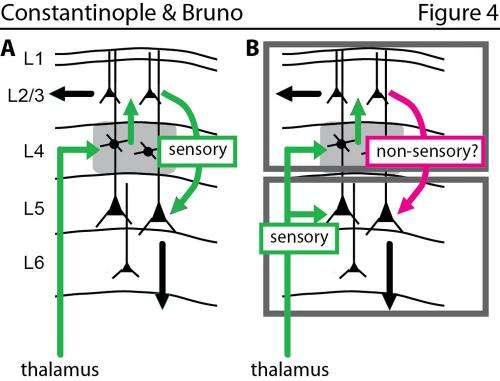Study appears to overturn prevailing view of how the brain is wired

A series of studies conducted by Randy Bruno, PhD, and Christine Constantinople, PhD, of Columbia University's Department of Neuroscience, topples convention by showing that sensory information travels to two places at once: not only to the brain's mid-layer (where most axons lead), but also directly to its deeper layers. The study appears in the June 28, 2013, edition of the journal Science.
For decades, scientists have thought that sensory information is relayed from the skin, eyes, and ears to the thalamus and then processed in the six-layered cerebral cortex in serial fashion: first in the middle layer (layer 4), then in the upper layers (2 and 3), and finally in the deeper layers (5 and 6.) This model of signals moving through a layered "column" was largely based on anatomy, following the direction of axons—the wires of the nervous system.
"Our findings challenge dogma," said Dr. Bruno, assistant professor of neuroscience and a faculty member at Columbia's new Mortimer B. Zuckerman Mind Brain Behavior Institute and the Kavli Institute for Brain Science. "They open up a different way of thinking about how the cerebral cortex does what it does, which includes not only processing sight, sound, and touch but higher functions such as speech, decision-making, and abstract thought."
The researchers used the well-understood sensory system of rat whiskers, which operate much like human fingers, providing tactile information about shape and texture. The system is ideal for studying the flow of sensory signals, said Dr. Bruno, because past research has mapped each whisker to a specific barrel-shaped cluster of neurons in the brain. "The wiring of these circuits is similar to those that process senses in other mammals, including humans," said Dr. Bruno.
The study relied on a sensitive technique that allows researchers to monitor how signals move across synapses from one neuron to the next in a live animal. Using a glass micropipette with a tip only 1 micron wide (one-thousandth of a millimeter) filled with fluid that conducts nerve signals, the researchers recorded nerve impulses resulting from whisker stimulation in 176 neurons in the cortex and 76 neurons in the thalamus. The recordings showed that signals are relayed from the thalamus to layers 4 and 5 at the same time. Although 80 percent of the thalamic axons went to layer 4, there was surprisingly robust signaling to the deeper layer.
To confirm that the deeper layer receives sensory information directly, the researchers used the local anesthetic lidocaine to block all signals from layer 4. Activity in the deeper layer remained unchanged.
"This was very surprising," said Dr. Constantinople, currently a postdoctoral researcher at Princeton University's Neuroscience Institute. "We expected activity in the lower layers to be turned off or very much diminished when we blocked layer 4. This raises a whole new set of questions about what the layers actually do."
The study suggests that upper and lower layers of the cerebral cortex form separate circuits and play separate roles in processing sensory information. Researchers think that the deeper layers are evolutionarily older—they are found in reptiles, for example, while the upper and middle layers, appear in more evolved species and are thickest in humans.
One possibility, suggests Dr. Bruno, is that basic sensory processing is done in the lower layers: for example, visually tracking a tennis ball to coordinate the movement needed to make contact. Processing that involves integrating context or experience or that involves learning might be done in the upper layers. For example, watching where an opponent is hitting the ball and planning where to place the return shot.
"At this point, we still don't know what, behaviorally, the different layers do," said Dr. Bruno, whose lab is now focused on finding those answers.
Nobel-prize-winning neurobiologist Bert Sakmann, MD, PhD, of the Max Planck Institute in Germany, describes the study as "very convincing" and a game-changer. "For decades, the field has assumed, based largely on anatomy, that the work of the cortex begins in layer 4. Dr. Bruno has produced a technical masterpiece that firmly establishes two separate input streams to the cortex," said Dr. Sakmann. "The prevailing view that the cortex is a collection of monolithic columns, handing off information to progressively higher modules, is an idea that will have to go."
"Bruno's work goes a long way toward overturning the conventional wisdom and provides new insight into the functional segregation of sensory input to the mammalian cerebral cortex, the region of the brain that processes our thoughts, decisions, and actions," said Thomas Jessell, PhD, Claire Tow Professor of Motor Neuron Disorders in Neuroscience and a co-director of the Mortimer B. Zuckerman Mind Brain Behavior Institute and the Kavli Institute for Brain Science. "Developing a more refined understanding of cortical processing will take the combined efforts of anatomists, cell and molecular biologists, and animal behaviorists. The Zuckerman Institute, with its multidisciplinary faculty and broad mission, is ideally suited to building on Bruno's fascinating work."


















